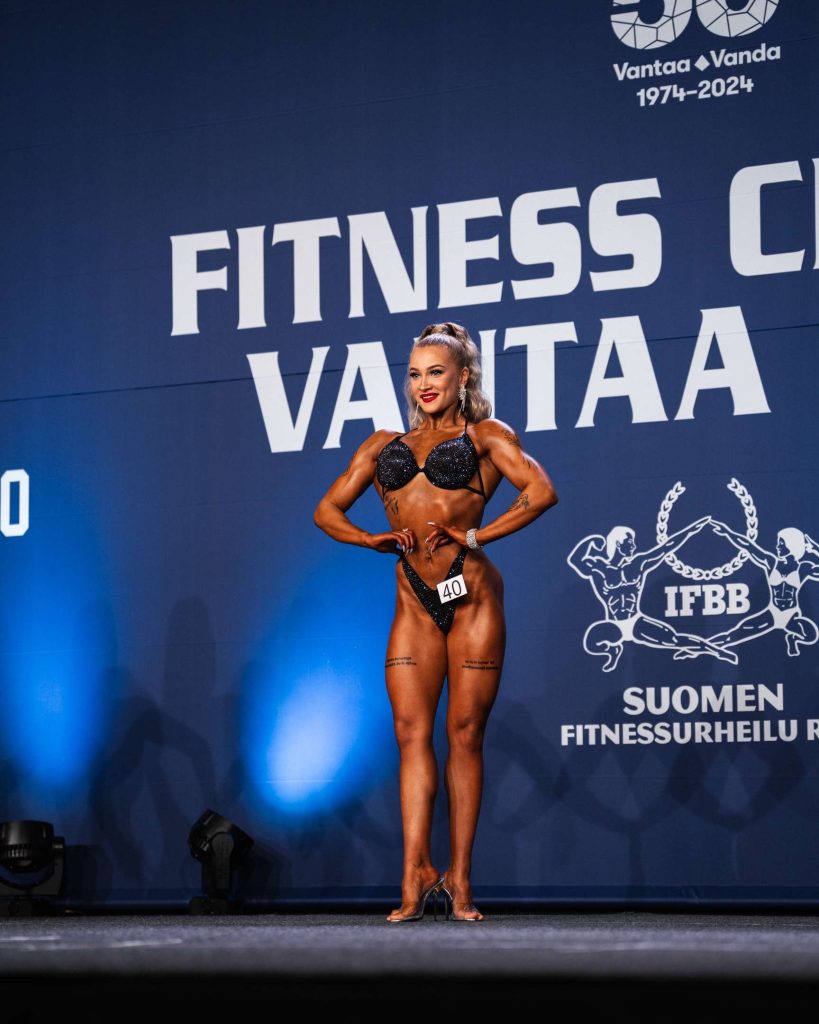Fitness athletes’ own experiences
Below you can see our second interviewee’s own experiences and thoughts on the sport.
Saara, 23 yrs., Team Step2Fit, Bodyfitness
Second we interviewed Saara. She is 23 years old and represents the Team Step2Fit team. Her sport is Bodyfitness (Body fitness is a sport that aims to build more muscle mass than bikini fitness). Before fitness, Saara has played ringette for 11 years from F-juniors up to SM level. In addition, she also played a few years of ice hockey. She has started fitness training in January 2022, but has been going to the gym since 2017.
“I got into fitness myself through the gym and following people competing in the sport on social media. In addition, two other competitors came to our gym, so it was through them that I got interested in the sport. Of course, at this point I had been going to the gym for 4-5 years.”

Saara has now started her off-season after a long, 1.5-year competition prep. Saara has competed for three seasons in a row, starting in November 2022 and continuing through many surprises until April 2024. In between the preps, however, there have been a few free eating periods, usually lasting 3-6 weeks. Currently, her workouts consist of 4 gym workouts with a few aerobic workouts around them. The gym workouts are split into 1 leg workout and the remaining 3 workouts are for the upper body.
“I have 6 competitions behind me, one of which is the World Championships! As an experience, the first competitions were just a touch and a look at the sport, no expectations and no knowledge of what the stage experience would be like. The second and third competitions were exciting in a different way, as the sport changed from wellness fitness to body fitness. The World Championships, on the other hand, were a completely different kind of excitement when it came to the International Championships. But as an experience, the World Championships were really great and unforgettable.”
Saara says that the last season and its competitions were the hardest for her, at least mentally. “A competition prep that goes on this long is really hard on the body, but also on the mind. Still, I don’t regret for a moment that we continued this long. It’s a time when you get to know yourself and your body super well, which is really important for your future.”
However, she says that the experience of the competitons itself has generally been positive every time.
“I enjoy being on stage, but the bigger thing for me is the journey to get there. It’s really important and motivating for me to beat myself and challenge myself every day. However, the hard weight training and improving is the most important thing for me. I don’t do fitness because I want to be judged on stage, but I do it because I love going to the gym and challenging myself every day, and competing is cherry on the top! And that should be every fitness athlete’s motivation to do this sport.”
Fitness as a hobby takes a lot of money, and Saara has not wanted to calculate her own income on an annual basis, but gave examples of how much money can possibly go to certain things. However, she says that you can influence how much money you spend.
“I’ve always tried to go with the cheapest. You can’t really influence the coaching fees themselves, because you don’t choose a coach based on price and it’s worth investing in. My coaching fees have been between 180-250€/month, when I have been with two different coaches. I have always bought used competition outfits, they cost 200-450€/each. Competition shoes were 90€, which of course I bought new! I probably could have got them cheaper second-hand. The gym card is 50 €/month and the food costs probably 200-300 €/month, but I would still buy these even if I wasn’t competing. I might even spend a bit more on food. The competitor’s licence is €250 per year and the competition fees are currently €100-150 per competition. I often do all the make-up and hair for competitions myself, but these can easily cost hundreds per competition. Competition colouring as a service is €130 per competition, but if you do it yourself, the price is around €50, because there are enough of the same colours for many competitions.”
“Accommodation and transport costs are all about where you live and whether you choose an Airbnb or a hotel! Personally, I prefer Airbnb apartments for competition trips because they feel more like a home and always have a kitchen and a bit of peace and quiet! They are also cheaper. If you decide to go to the international championships, all flights/boats are expensive. You don’t have to take pictures of the competitions, but I’ve spent 50-130€/competition on these. Of course, there are all the “hidden costs” of buying candy, wine, plastic wrap (to protect the toilet bowl for the competition colour), etc., whatever you need if you can’t find it at home.”
Prior to entering competition coaching, Saara had been going to the gym for about 5 years. The plans for the competition were finalized almost as soon as the training started. The off-season lasted for about nine months before the first competition prep.
“There are always some minor illnesses at prep, but otherwise everything went well, except for the last prep. Three months before the competition I tore ligaments in my ankle and I went two months without training my legs properly and one month without doing any cardio or jogging. Posing was very difficult with one heel and a broken leg, but somehow I still managed to do it. At the beginning of the last prep there was a divorce and a move, which was a bit of a mental wobble, but in the end, despite these adversities, the prep went really well.”
Saara says that as a competitive athlete, you have to think about every choice you make in order to support your own fitness. Everything has an impact on how you manage your everyday life. Eating, sleeping, training, aerobic exercises and posing must be able to fit into your everyday life so that you can cope. As a competitive athlete, other “extras” such as a social life often have to take a back seat, which is a shame, but as a competitive athlete there is little “free time”.
“Depending on the coach, you can influence the form of training. With a coach it is possible to make a training programme that suits you. But you have to remember that if you want to improve, you have to go outside your comfort zone and do things that are not necessarily the most fun.”
Saara says that her absolute favourite food on the diet is chicken, rice and broccoli. In the mornings and evenings she likes to eat porridge. In the off-season, she would not eat these foods as reduced as she does on the diet. On the competition diet, everyone also has a special “treat” that they like to eat, which may not necessarily work as a treat during the off-season.
“On my last prep my delicacy was pickles and tomatoes, the one before that was sauerkraut and beetroot. I’ll admit to myself that kind of indulgence in prep, but these all go with the macros! So if I want treats, then I have to pinch off the food that goes into the macros of those treats. Otherwise, when you are hungry you wouldn’t even want to trade, for example, 40 grams of porridge to one ice cream! The first day after the competition, we went to the restaurant to eat just basic Mexican food, which is a prep end tradition for me. But the first thing I put in my mouth right after the stage is water and a banana.”
There are downsides to fitness, but there are always downsides in sports, especially if you’re competing at the top. Saara says that the potential risks of fitness include eating disorders, body image changes, self-esteem issues, endocrine and recovery-related health risks.
“This is a judged sport, where your body is judged and compared to others. If the competition doesn’t go the way you wanted or expected it to, it can feel really, really bad and then you start going through all the thoughts about how you’re worse than someone else. Especially people who are as self-critical as I am, so it really hits you in a different way. But all these bad aspects are worth discussing with the coach.”
Apart from the injury mentioned earlier, Saara has always done well without any major setbacks. At the moment, her goal is to develop as much as she can, get some hard and developmental training under her belt and, above all, enjoy the off-season. “The next competitions are already set, so let’s go towards them!”
Alongside fitness, Saara works as a security guard and her shifts are usually 12 hours. She says that fitness as a sport is sometimes difficult to fit in alongside such shifts. She also says that on her days off, she can usually manage to work out, but her working days are often so demanding that it’s hard to go out and work out.
“Especially if you have long working hours and only sleep at home between days, it takes a bit more recovery afterwards, and the workouts aren’t always the best. Not to mention our night shifts, which probably don’t even need to be mentioned.”
Thanks to Saara and Riia for participating in the interview!
Ideation, writing and planning: Sarianna Virtanen, Suvi Rantala & Heini Lehtiranta

